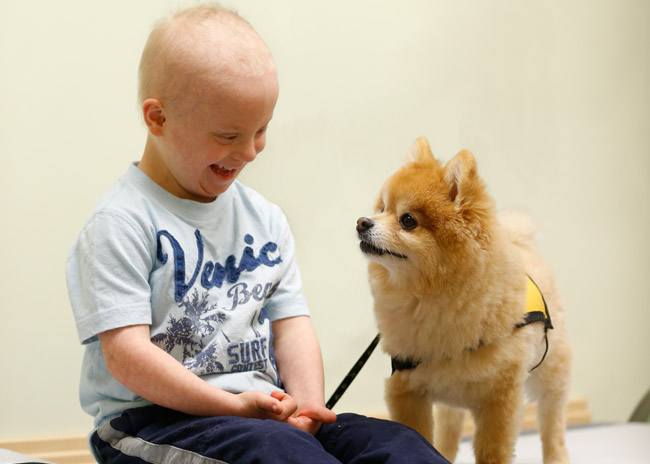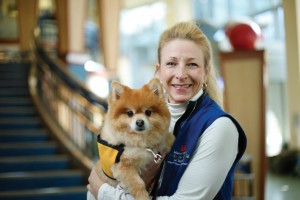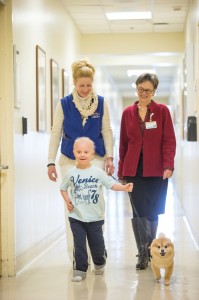
A national study of young cancer patients at Vanderbilt University Medical Center and four other sites doesn’t focus on experimental medications or therapies, or even the doctors and nurses who administer them. The most important member of this health care team is a tiny 10-pound toy Pomeranian named Swoosh. The “medication” being studied comes in the form of licks, tricks and a wagging tail.
Six-year-old JonJon Huddleston of Nashville is one of 20 children participating in the Vanderbilt portion of the Canines and Childhood Cancer study, evaluating the benefits of animal-assisted therapy for young cancer patients who are newly diagnosed and undergoing chemotherapy.
The Vanderbilt portion of the five-center study is led by Vanderbilt University School of Nursing professor Mary Jo Gilmer, PhD, MBA, RN-BC, FAAN.
Specifically the study is looking at whether animal-assisted therapy reduces the stress of anxiety of the children undergoing chemotherapy, and whether it improves the quality of life for the children (ages 3-17) and their families. Twenty children at each site are randomly assigned into one of two groups—one receiving the standard of care therapy and another receiving standard of care therapy plus animal-assisted therapy. At the time the families agree to be in the study, they don’t know to which group they’ll be assigned. They are followed for four months.
JonJon, waiting for his appointment in the Pediatric Oncology Clinic at Monroe Carell Jr. Children’s Hospital at Vanderbilt, throws his head back and laughs as he runs his tiny fingers through Swoosh’s silky soft reddish brown hair. The distraction takes his mind off of his impending chemotherapy treatment for acute lymphoblastic leukemia (ALL).
JonJon’s mom, Amy Huddleston, sits beside him in the exam room, a Starbucks coffee cup in her hand and a smile on her face as she watches her son interact with Swoosh and Michelle Thompson, the 7-year-old therapy dog’s owner and handler.
Swoosh sits in the chair with JonJon, but watches Thompson closely for hand commands. The dog’s tiny yellow vest with the black border signals he’s at work.
Gilmer, a palliative care expert, is watching Swoosh and JonJon through a glass window. She can’t hear what’s being said, but a Vanderbilt student research assistant inside the room is filming the interaction and it will be evaluated at a later date. She doesn’t need to hear the conversation to know that JonJon is delighted with the tricks that Swoosh is performing beside him.
The study is coordinated by the American Humane Association and funded by animal health company Zoetis.
Co-investigators include Terrah Foster Akard, PhD, RN, assistant professor of Nursing, and Debra Friedman, MD, E. Bronson Ingram Professor of Pediatric Oncology and director of Hematology/ Oncology at Children’s Hospital. Research Assistants helping with the study include undergraduate and graduate students from Nursing, Peabody Child Development, College of Arts and Science, and Medicine Health and Society.
Other sites participating in the study are: Randall Children’s Hospital in Portland, Oregon; St. Joseph’s Children’s Hospital in Tampa; Tufts School of Veterinary Medicine in Boston; and UC Davis Children’s Hospital in Sacramento.
Each year in the U.S., more than 15,000 children and adolescents under 19 will be diagnosed with cancer, according to the National Cancer Institute. ALL is the most common cancer diagnosed in children, and represents approximately 25 percent of cancer diagnoses among children younger than 15. ALL treatment lasts about two years for females and three years for males.
“Great strides have been made in treating cancer and the survival rate has increased greatly over the last few years,” Gilmer said. “When I started out in nursing we lost about 50 percent of the kids with ALL. Now the survival rate is about 85 percent.
“We’ve made great progress. That’s the good news,” she said. “The difficult news is that kids are living with the effects of cancer. Survivors live with the emotional stress of the diagnosis and treatment for the rest of their lives, and their families are affected too.”
Gilmer said that although animal-assisted therapy has expanded in recent years, most of the findings about the benefits have largely been anecdotal. It’s not clear, from a scientific standpoint, that the incorporation of animals into clinical settings is effective, thus the need for this multi-center study. During the study surveys and physiological data are collected from the participating families (quantitative data) and stories as well (qualitative).
Typically children with ALL receive one month of chemotherapy in the hospital, followed by weekly chemotherapy visits in the clinic setting. This is where the study visits take place.
In addition to evaluating the impact of pet therapy on anxiety and health-related quality of life of the children, the stress levels of the dogs will also be monitored. After meeting with each study participant, the dog’s mouth is swabbed to collect saliva and measure cortisone levels.
“There’s everyday ‘good’ stress that the dog can feel when meeting people or trying something new, and there’s ‘bad’ stress or distress that can be debilitating,” Gilmer said. “We want to check after they’ve been with a child who’s so sick. The human-animal bond is so tight.”
Swoosh’s Story
Swoosh and Thompson were certified as a pet therapy team in fall 2011 by Therapy ARC (Animals Reaching Clients), a local non-profit organization. The volunteer duo started out visiting adult patients receiving cancer treatments and pediatric physical therapy patients at Vanderbilt Health One Hundred Oaks (a satellite facility of Vanderbilt University Medical Center).
In the summer of 2012, they started working at Children’s Hospital with pediatric patients receiving chemotherapy, and were recruited to join the Canines and Childhood Cancer study. They spend 15 minutes with the study participants each time they visit the outpatient clinic.

When Thompson and Swoosh pay a visit to the clinic, Swoosh will sit in the child’s lap, shake hands, and the child often is allowed to give him treats. Sometimes the child listens to Swoosh’s heart with a stethoscope, brushes him or reads a book to the dog. And there are tricks—Swoosh can retrieve a ball and jump over poles.
“Mostly, we’re just there to distract, for the child to take a break from being in the hospital,” Thompson said. “I trained him to be calm. The breed is normally a little hyper, insecure and yippy, but I worked with him as a puppy and he’s smart. Not every dog can be a therapy dog, just like not every person can be a nurse. He’s just mostly a warm little fluffy thing.”
Thompson said that when she visits children in the hospital, she looks for “a twinkle” in a child’s eye when she and Swoosh stop to say hello. “Not everybody is a dog fan. You can tell right away if they’re receptive,” she said.
Amy Huddleston admits that she was slightly reluctant to enroll JonJon in the study when she was first approached at Children’s Hospital. “He was very sick and this was a very new diagnosis. I didn’t want one more thing to do, one more thing to fill out.”
But she agreed and says the study has been a big help in getting JonJon, and she and her husband, Jono, through the early days of a frightening diagnosis. Prior to being enrolled in the study, JonJon would realize as they got close to Children’s Hospital and say “no, no, no.” After meeting Swoosh, if she had trouble getting him out the door and into the car, she’d say, “We’re going to see Swoosh,” and he’d stop what he was doing and readily get in the car to head to Vanderbilt.

“It was amazing,” she said. “This (being teamed up with Swoosh and Thompson) has changed his whole demeanor. Now when we come to the hospital there are no tears and he doesn’t tense up. When we get near the hospital, he’ll start to say ‘Swoosh!’ It’s been wonderful for us, a fabulous experience. It’s made a huge difference.”
Although there are four other dogs participating in the study (Orla, Owen, Kevlar and Johnny), Swoosh does most of the interactions because of his availability.
“Swoosh is wonderful. Michelle is great,” Gilmer said. “They come as a package. Animal-assisted therapy, because they’re volunteers, doesn’t cost anything. It’s very cost effective, children love it and anecdotally we know it works. In this health care environment, that’s very important.”
Michelle and Swoosh are integral team members, said Stephanie Van Dyke, director of Child Life and Volunteer Services for Children’s Hospital. “Not only do they exhibit the heart of a servant through volunteer service, with every visit they help reduce stress and anxiety and normalize the health care experience for children and their families. They motivate and inspire. They personalize health care experiences. They complement the medical treatment so that the whole child is being cared for—physically, emotionally and developmentally. When we speak of a healing environment, we speak of Michelle and Swoosh,” Van Dyke said.
Swoosh and Thompson have other responsibilities as well—they work with military personnel, the elderly and school children, and participate in a local program that aids struggling readers.
Early Indicators
A student research assistant attends each animal-child interaction along with the child’s parent, dog and animal handler. Data collected includes blood pressure and pulse before and after the child’s 15 minutes with the dog and surveys to show the current level of anxiety or stress.
There are also quality-of-life questionnaires with questions about quality of life in general, and about quality of life specific to cancer. A video camera is used to record each session so independent observers can document the dog’s behavior. The control cohort sessions are also videotaped to ensure an equivalent environment.
Gilmer emphasized that children randomized into the group without animal-assisted therapy can still interact with the therapy dog as it makes its way through the clinic with its handler. They just don’t get the 15 minutes with the dog in the exam room.
Gilmer’s interest in animal-assisted therapy began years ago when she had a National Institutes of Health (NIH)-funded grant looking at coping and adjustment in bereaved parents and siblings after a child dies from cancer. In that study, one of the questions asked was ‘who provides support for you?’ There was a checklist that included parents, friends, teachers, coaches, ministers and pets. “Almost as many checked pets as did parents or friends, which was very surprising to me,” she said. “That inspired me to look at the importance of pets more carefully.”
Gilmer said it’s too early to know what the results of the current study will be, but her observations have given her a clue.
“There’s just a change in the affect of the kids assigned to the animal therapy group,” Gilmer said. “They light up. They want to interact with the dog, and what I’ve heard from the parents is that the dog becomes important in getting the child to come to clinic. One little 4-year-old girl had 15 minutes with Swoosh and as she was exiting the session, she said, ‘I’m ready for my spinal tap now.’ I couldn’t believe it. That’s pretty dramatic.”
– Nancy Humphrey